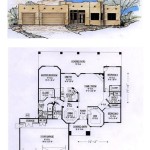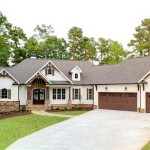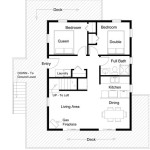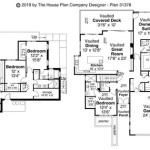Two-Story House Plans With Balconies: Design and Functionality
The allure of a two-story house plan lies in its potential for both spacious living and efficient land use. When augmented with balconies, these homes gain an additional layer of sophistication and practicality, seamlessly blending indoor and outdoor living. This article will explore the various facets of two-story house plans incorporating balconies, delving into design considerations, functional benefits, and different architectural styles that complement this feature.
A balcony, architecturally defined, is an accessible platform projecting from the wall of a building, supported by columns or console brackets and usually enclosed by a balustrade or railing. In the context of residential architecture, balconies serve as extensions of interior spaces, providing private outdoor areas for relaxation, entertainment, or simply enjoying the surrounding views. The integration of balconies into two-story house plans requires careful planning and consideration of several factors to ensure structural integrity, aesthetic appeal, and functional relevance.
Optimizing Space and Enhancing Views
One of the primary advantages of incorporating balconies into a two-story house plan is the optimization of space, particularly in areas where lot sizes are limited. A balcony effectively extends the living area onto the exterior, providing a valuable outdoor space without significantly increasing the overall footprint of the house. This feature is particularly beneficial in urban or suburban environments where access to large yards may be restricted.
Furthermore, balconies offer opportunities to maximize views. Strategically positioned balconies on the second story can capture panoramic vistas of the surrounding landscape, whether it be a cityscape, a natural landscape, or a waterfront view. These balconies become prized locations within the home, offering residents a private sanctuary to appreciate their environment. The orientation of the balcony is crucial in maximizing the view and minimizing exposure to undesirable elements like harsh sunlight or strong winds. This requires a thorough understanding of the site’s topography and prevailing weather patterns.
The design of the balcony itself should complement the architectural style of the house. A modern house might feature balconies with clean lines and minimalist railings, constructed from materials like glass and steel. A traditional-style house, on the other hand, might incorporate balconies with ornate iron railings and decorative columns. The choice of materials and detailing should be consistent with the overall aesthetic of the home, ensuring a cohesive and visually appealing design.
The accessibility of the balcony is another important consideration. Balconies are typically accessed directly from interior rooms, such as bedrooms, living rooms, or home offices. The placement of the access door should be carefully considered to ensure smooth flow between the interior and exterior spaces. Wide, sliding glass doors are often used to maximize natural light and provide unobstructed views from the interior. The placement of furniture on the balcony should also be considered during the design phase, ensuring that there is ample space for comfortable seating and movement.
The structural integrity of the balcony is paramount. Balcony construction must adhere to local building codes and regulations, ensuring that it can safely support the intended load. This often involves working with a structural engineer to design a robust support system that can withstand the weight of occupants, furniture, and potential snow or wind loads. The choice of materials for the balcony deck is also important, selecting durable and weather-resistant options that can withstand the elements for many years.
Balconies as Architectural Style Statements
Balconies can serve as significant architectural elements that define the style and character of a two-story house. Different architectural styles incorporate balconies in unique ways, reflecting the design principles and aesthetic preferences of each era and region. For example, in Mediterranean-style homes, balconies are often featured prominently, with wrought iron railings, stucco walls, and arched openings. These balconies evoke a sense of old-world charm and are often used as extensions of the living spaces, blurring the lines between indoors and outdoors.
In contrast, modern and contemporary homes often feature balconies with clean lines, minimalist detailing, and an emphasis on functionality. These balconies are typically constructed from materials like glass, steel, and concrete, creating a sleek and sophisticated appearance. The railings are often designed to be as unobtrusive as possible, maximizing views and creating a seamless connection between the interior and exterior spaces.
Victorian-style homes frequently incorporate balconies with ornate detailing, such as decorative brackets, turned columns, and intricate railings. These balconies add a touch of elegance and grandeur to the façade of the house, reflecting the elaborate aesthetic of the Victorian era. The materials used in the construction of these balconies are often chosen for their durability and aesthetic appeal, such as wood, cast iron, and decorative tiles.
The size and shape of the balcony can also contribute to the overall architectural style of the house. Small, Juliet balconies, which are essentially decorative railings attached to a window or door, can add a touch of romance and charm to any style of home. Larger balconies, on the other hand, can serve as functional outdoor living spaces, providing ample room for seating, dining, and entertaining.
The placement of the balcony on the façade of the house can also influence its architectural impact. A balcony that wraps around the corner of the house can create a dynamic and visually interesting design, while a balcony that is recessed into the façade can provide a more private and sheltered outdoor space. The relationship between the balcony and the windows and doors of the house is also important, as it can affect the amount of natural light and ventilation that enters the interior spaces.
Functional Advantages and Design Considerations
Beyond their aesthetic appeal, balconies offer several functional advantages that enhance the livability of a two-story house. Balconies provide a private outdoor space for relaxation, entertainment, and enjoying the surrounding environment. They serve as an extension of the interior living area, allowing residents to seamlessly transition between indoors and outdoors. This is particularly valuable in climates with mild weather, where the balcony can be used year-round.
Balconies can also improve the ventilation of the house. By opening the doors or windows that lead onto the balcony, residents can allow fresh air to circulate through the interior spaces, reducing the need for air conditioning and improving indoor air quality. This is especially beneficial during the spring and fall months, when the weather is pleasant and the air is fresh.
Furthermore, balconies can provide additional natural light to the interior spaces. By allowing sunlight to enter through the doors and windows that lead onto the balcony, residents can reduce the need for artificial lighting during the day, saving energy and creating a more pleasant and inviting atmosphere. The placement of the balcony should be carefully considered to maximize the amount of sunlight that enters the interior spaces, taking into account the orientation of the house and the surrounding landscape.
The design of the balcony should also take into account the privacy needs of the residents. Balconies can be designed to provide a sense of seclusion and privacy, shielding residents from the view of neighbors or passersby. This can be achieved by incorporating features such as privacy screens, plants, or strategically placed walls. The choice of railing material and design can also contribute to the privacy of the balcony, with solid railings providing greater privacy than open railings.
The safety of the balcony is another important consideration. Balconies should be designed and constructed to meet all applicable building codes and safety standards, ensuring that they are safe for occupants of all ages. The railing height should be sufficient to prevent falls, and the railing should be securely attached to the building structure. The balcony deck should be constructed from a durable and slip-resistant material, and the balcony should be regularly inspected and maintained to ensure that it remains in good condition.
Finally, the maintenance of the balcony should be considered during the design phase. The materials used in the construction of the balcony should be chosen for their durability and resistance to weathering. The balcony should be designed to allow for easy cleaning and maintenance, and the railing should be regularly inspected and repaired as needed. Proper maintenance will ensure that the balcony remains a safe, attractive, and functional feature of the house for many years to come.

Modern House Design 2024005 Pinoy Eplans Two Y Plans Construction Plan

Two Y House Plans With Balcony 80 Designs Contemporary Design

Two Story 4 Bedroom Southern Home With Elevator And Second Floor Balconies Plan Balcony House Plans Florida

Double Y House Plan With Balcony Pinoy Designs

Building Designs By Stockton Plan 2751 Double Y House Plans Story

Modern Two Story House Design 4 Bedroom Floor Plan Nethouseplansnethouseplans

Double Y House Plan With Spacious Balcony Cool Concepts

Two Story 4 Bedroom Southern Home With Elevator And Second Floor Balconies Plan Plans Balcony Florida House

Affordable Modern Two Story House Plan With Large Deck On Second Floor 9690

Double Y House Plan With Spacious Balcony Cool Concepts








